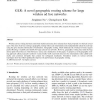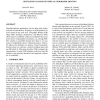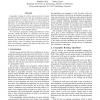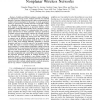CN
2006
14 years 3 months ago
2006
Wireless ad hoc routing has been extensively studied and many clever schemes have been proposed over the last several years. One class of ad hoc routing is geographic routing wher...
WSC
2004
14 years 5 months ago
2004
Homeland defense applications will use large-scale ad-hoc networks of small devices. Routing is a crucial problem, for naive means do not scale well. Geographic Routing (GR) (Karp...
ICA3PP
2009
Springer
14 years 8 months ago
2009
Springer
We present Obstacle-aware Virtual Circuit geographic Routing (OVCR), a novel routing mechanism for obstacle-aware wireless sensor networks that uses the obstacle-free path computed...
SENSYS
2003
ACM
14 years 9 months ago
2003
ACM
In the absence of location errors, geographic routing - using a combination of greedy forwarding and face routing - has been shown to work correctly and efficiently. The effects o...
MSWIM
2003
ACM
14 years 9 months ago
2003
ACM
Recently, geographic routing in wireless networks has gained attention due to several advantages of location information. Location information eliminates the necessity to set up a...
ICDCSW
2005
IEEE
14 years 9 months ago
2005
IEEE
Due to the utilization of location information, geographic ad hoc routing presents superiority in scalability compared with traditional topology-based routing in mobile ad hoc net...
SENSYS
2006
ACM
14 years 9 months ago
2006
ACM
Geographic techniques promise highly scalable any-toany routing in wireless sensor networks. In one thread of research on geographic routing, researchers have explored robust, dis...
ICWMC
2006
IEEE
14 years 9 months ago
2006
IEEE
Geographic routing in wireless sensor networks is based on the prerequisite that every node has information about its current position, for instance via GPS or some localization a...
INFOCOM
2007
IEEE
14 years 10 months ago
2007
IEEE
— Scalable and efficient routing is a main challenge in the deployment of large ad hoc wireless networks. An essential element of practical routing protocols is their accommodat...
INFOCOM
2007
IEEE
14 years 10 months ago
2007
IEEE
— It has been a big challenge to develop routing protocol that can meet different application needs and optimize routing paths according to the topology change in mobile ad hoc n...




